This was a hike offered by Walk2Connect in honor of Boulder's Walk & Bike Month (June). It "traverses the western edge of the city, from Dakota Ridge in the north to Shanahan Ridge in the south. The route follows close-in Open Space and Mountain Parks trails, as well as some connecting multi-use paths and sidewalks. We'll explore the beautiful variety of terrain within the city's boundaries, from the open meadows and rolling hills around Wonderland Lake to the stunning red rock formations above Settler's Park and the dense pine forests on Kohler Mesa."
Learn more at walk2connect.com
It had been a while since I'd done a hike this big (11+ miles) so I was a bit nervous... but I signed up anyway.

Here was the planned route (click for a larger view)
18 of us made our way to the trailhead either by carpool or bus. After some basic introductions, we set out shortly after 9 am. Our leader was Darcy, a highly competent, energetic and fun woman with whom I had already done many hikes.

Our starting point


The first leg of the trip would take us along the Foothills South trail past Wonderland Lake.

Now you know the hang-gliding rules...

... and the drone rules, apparently. It makes me wonder what's going to come next!

A Mule Deer stopped to check us out before disappearing quickly into the trees. Mule deer are distinguished by their large ears (hence their name) and thin black-tipped tails.
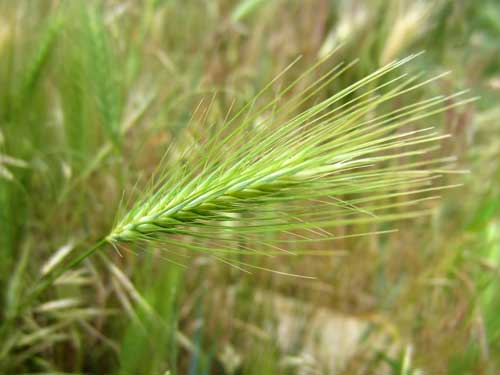
This area is the western end of the Great Plains. As such, there's a wide variety of grasses... some native, but many not. This is possibly Canada or Nodding Wild Rye, a grass native to much of North America and abundant in the Great Plains.

Cheatgrass (also called Downy Brome) is one of the most invasive weeds in North America. It was accidentally introduced via Eurasian grain imports in the 1800's. The grass sprouts early, thereby 'cheating' native plants out of spring water and nutrients. It is highly adaptable, can dramatically alter the ecosystems it invades, and burns easily then recovers quickly before other vegetation.

Redstem Stork's Bill goes by many names... Filaree, Heron's Bill, Pin Clover, Common Crowfoot and more. It is believed to be one of the earliest European plants to come to North America, apparently introduced to California by Spanish explorers in the early 1700's. While quite pretty and often a good source of food for wildlife, it is listed as a Class C Noxious Weed in Colorado.
The Colorado Noxious Weed Act was created in 1990 to protect natural and agricultural resources. Weeds are prioritized as such:
- List A species are required to be completely eliminated.
- List B species are plants whose continued spread should be contained.
- List C species may be required to be controlled (but are often too widespread and well established).
- Watch list species are plants whose distribution is not yet fully understood.

Alfalfa was introduced to Colorado by former Governor Alexander Hunt in 1863. Popular as a livestock forage crop, it has since escaped the farms and gone wild.

Approaching damage from the September 2013 flood, when a tiny creek from Four Mile Canyon became a roaring, ravaging river


Stream crossing

Enjoying plenty of blooming beauty along the Foothills South trail
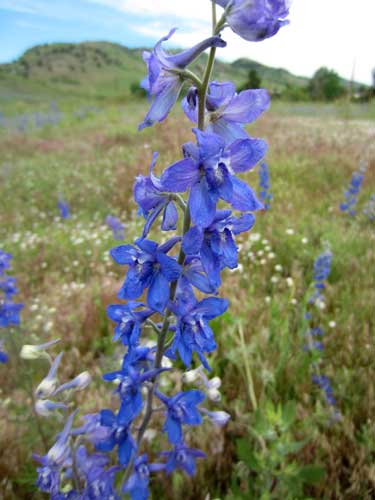
Larkspur is a spring flower that can fill up meadows. The color ranges from pink to purple to blue... there's even a white version.

Western Spiderwort (also Spiderlily) flowers have a very short life... only a single morning, but each plant will produce 20 or more flowers per stem. This native plant was used to treat spider bites and other ailments. Apparently it has the natural ability to detect radiation, which makes the blue stamens on the flowers turn pink!

Yellow or Western Salsify (also known as Goatsbeard or Wild Oysterplant) is a member of the sunflower family. It was introduced to America by early Europeans because it has edible roots. Although technically a weed, it seems to have very little negative impact.

A quiet day for the windsock. The Rocky Mountains stand directly in the path of strong west-to-east air currents over North America. When air flows over them, the peaks of the Continental Divide act like rocks in a stream bed, producing a series of waves. Where the waves dips down, as in Boulder where the mountains meet the plains, violent winds up to 100 miles per hour are created. Along with causing millions of dollars of damage per year, these dry downslope winds (called the Chinook, after the Native Americans of the Pacific northwest, where the winds originate) can melt a foot of snow in less than a hour.

Making our way south
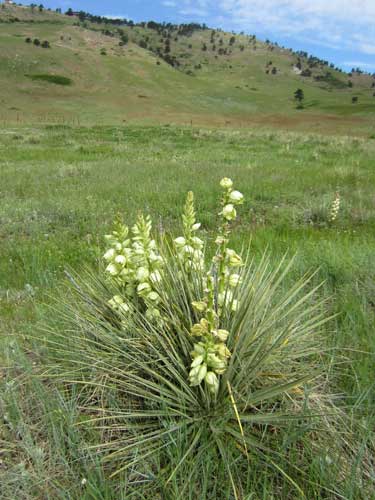
Yucca (also Soapweed or Spanish Bayonet) is actually an evergreen, trunkless shrub. The flowers are only pollinated by a very specific moth. One can not survive without the other.

Approaching Wonderland Lake, a 34-acre lake with a maximum depth of 13 feet
Construction on Silver Lake Ditch began in 1888 by George Oliver and James P. Maxwell. It brought water from Arapaho Glacier all the way down through Boulder Canyon via a long series of wooden flumes and tunnels to North Boulder. In 1907, William W. Degge bought it as well as large tracts of land in the area. He built Mesa Park Reservoir (Wonderland Lake) and Mesa Reservoir (Hank Roberts Lake) and attempted to sell the newly irrigated parcels of property. Wellington Gardens was to be 2,800 acres of of 'prosperous homes for thrifty people.' Degge promised 99.996% pure water from melting snow and glacier ice. But he never sold as many lots as he hoped and the ditch was not able to deliver the amounts of water he promised. Today much of his land is Boulder Open Space.

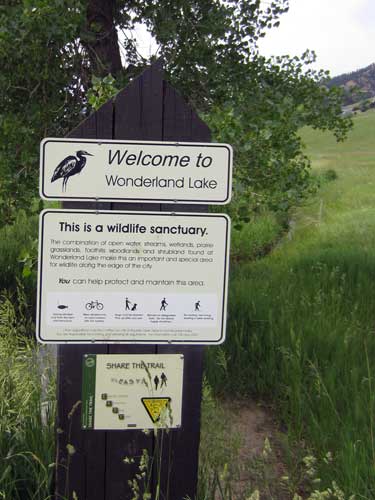

A paraglider makes a brief appearance over a hill.
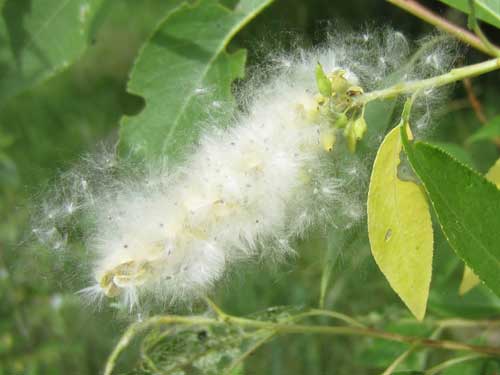
The Narrowleaf Cottonwood (or Willow-leaved Poplar) has catkins that produce all that white fluff (or 'cotton') floating around in the air. This allows the seeds to spread over long distances in the wind. Cottonwoods only grow in wet soil and are found along lakes, riverbanks and irrigation ditches.

Colorado has 15 species of native thistles and 5 non-native ones that are listed on the Noxious Weed List. How do you tell them apart? Generally, the noxious ones are in dense stands and are very tall (up to 6 feet). Native ones tend to be short, often white, and are usually only found as individual plants or in very small groups of 2 - 4.

This is possibly Smooth Brome. A native of Europe, it was introduced in the late 1800’s to 'increase productivity of grasslands.' While not considered a noxious weed, it is currently known as 'the silent invader' in that it very slowly (over the course of decades) transforms native grasslands into a near monoculture.


Darcy lines us up for a group shot.


This charming flower goes by the names of Copper Mallow, Scarlet Globemallow or Cowboy's Delight.

Walking along the edge of civilization
In the 1950's, Boulder was in the middle of a massive growth spurt. The big concern was that houses would continue to be built all the way up the foothills. So in 1959, voters overwhelmingly approved the Blue Line, a boundary that restricted city water service to altitudes below 5,750 feet. Many development plans, including a subdivision on what is currently NCAR, were scrapped. However, people could still build wells. So in 1967, a dedicated sales tax was approved to enable the city to buy up land for open space and contain urban sprawl. A height ordinance on new buildings was also added in 1972.... although where's there's money, there always seems to be exceptions.

Giant eyesores still seem to have found their way into the pristine beauty.

The conflict of interest... houses vs. nature

Darcy guides us safely across Linden Ave.

Starting our walk across the Dakota Ridge

Colorado or Purple Locoweed produces a substance called swainsonine, an alkaloid that inhibits enzyme production involving sugar and carbohydrate metabolism. As a result, partially metabolized sugars build up in the brain, resulting in brain damage and permanent neurologic damage. Symptoms may include lethargy, emaciation due to an inability to eat or drink, weakness, irregular gait or loss of muscular control, erratic behavior, extreme nervousness and overreaction, even death. What makes locoweed so dangerous is that is extremely palatable to cattle, sheep and horses (and even elk and deer). It becomes very difficult to stop animals from eating the plant even if other forage is provided.

The very steep ascent up Goat Trail
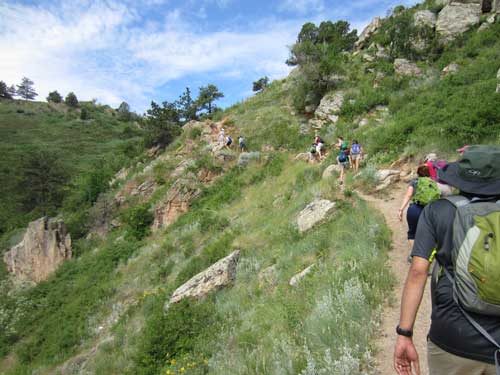
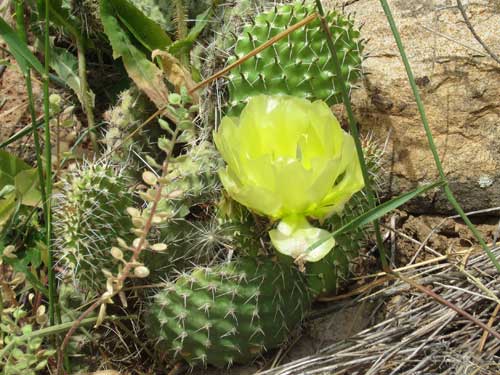
Like all true cactus species, prickly pears are native only to the Americas, but they have been introduced to other parts of the world. They are the most cold-tolerant of the lowland cacti. Both the pads (which are actually the stems of the plant) and fruit are edible.

Scarlet Gaura is in the evening primrose family and also goes by the names of Scarlet Beeblossom and Butterfly Weed... which seems a bit ironic since it is pollinated neither by bees nor butterflies but rather by night-flying moths (although the butterfly description can perhaps be applied more to the flower petals resembling wings). The flowers only last a single day and fade from white to pink and finally scarlet.

Aromatic or Three-leaf Sumac is also called Sourberry or Skunkbush. The fruit is edible but quite sour and the crushed leaves have a very strong, disagreeable scent. Historically it has been used for medicinal purposes.

Getting higher...

... with an amazing view now behind us!


There are 62 species of penstemons native to Colorado. Were I to guess at this one, I would say One-sided Penstemon (also called Sidebells Penstemon or Orchid Beardstongue).

Common or Yellow Toadflax also has the charming name of Butter-and-eggs. Unfortunately it is on our B list of noxious weeds. It is an escaped ornamental plant that is native to the Mediterranean.

Why must one person's 'great view' ruin the view for everyone else? Too bad they don't have a 'noxious houses' list.

Success at the top!

